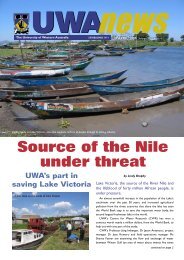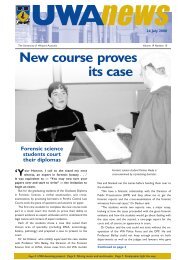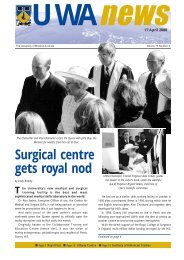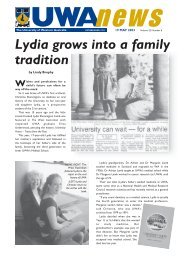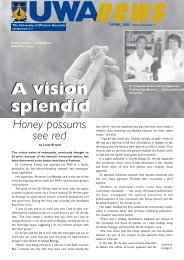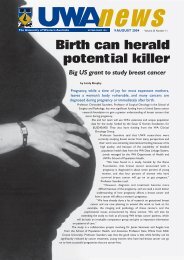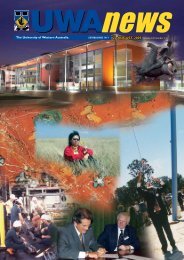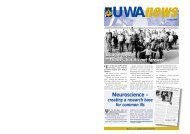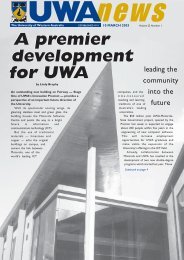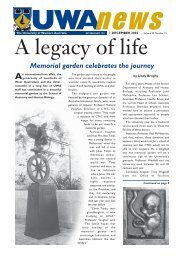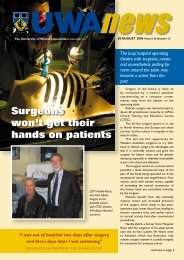Annual Report 2005 - Publications Unit - The University of Western ...
Annual Report 2005 - Publications Unit - The University of Western ...
Annual Report 2005 - Publications Unit - The University of Western ...
- No tags were found...
Create successful ePaper yourself
Turn your PDF publications into a flip-book with our unique Google optimized e-Paper software.
1. Summary <strong>of</strong> significant accounting policies (continued)THE UNIVERSITY OF WESTERN AUSTRALIANOTES TO THE FINANCIAL STATEMENTS31 DECEMBER <strong>2005</strong>(l)Property, plant and equipmentProperty, plant and equipment is measured at cost less accumulated depreciation less accumulated impairment losses.Where an asset is acquired at no cost or for a nominal cost, the cost recorded is the fair value <strong>of</strong> the asset at theacquisition date.Subsequent costs are included in the assets carrying value or recognised as a separate asset, where appropriate, whenit is probable that future economic benefit associated with the asset will flow to the <strong>University</strong>. All other repairs andmaintenance are charged to the income statement when incurred.<strong>The</strong> depreciation rate policy is as follows:Asset classLeasehold landFreehold landBuildingsComputer hardwareEquipmentMotor vehiclesArtworksSpecial collectionsLibrary booksDepreciation rateNot depreciatedNot depreciated2% reducing balance25% straight line12.5% straight line17.5% straight line if held more than one yearNot depreciatedNot depreciatedDepreciated 100% in fourth year after acquisitionAssets’ residual values and useful lives are reviewed at each balance sheet date. Pr<strong>of</strong>its and losses on disposal arerecorded in the income statement for the year.Impairment testing is performed when an indicator <strong>of</strong> impairment is identified.(m)ImpairmentAssets that have an indefinite useful life are tested annually for impairment. Assets with a finite life are tested forimpairment when events or changes in circumstances indicate the carrying value may not be recoverable.An impairment loss is recognised for the amount by which the asset’s carrying value exceeds the recoverable amount.<strong>The</strong> recoverable amount is the higher <strong>of</strong> its fair value less costs to sell and its value in use. As the <strong>University</strong> is a not-forpr<strong>of</strong>itentity, if the future economic benefits <strong>of</strong> the asset are not primarily dependent on its ability to generate net cashflows, unless the asset has been identified as surplus, the value in use is its depreciated replacement cost.(n)Intangible assetsIntangible assets are capitalised at cost and from a business combination are capitalised at fair value as at the date <strong>of</strong>acquisition. Following initial recognition, the cost model is applied to the class <strong>of</strong> intangible assets.Expenditure on research activities is recognised as an expense in the income statement when incurred. Expenditure ondevelopment activities is expensed unless the outcome is technically and commercially feasible, resources are availableto complete the development and there is a commitment to complete the project.Amortisation is calculated on a straight line basis over the estimated useful life <strong>of</strong> the asset. <strong>The</strong> useful life <strong>of</strong> s<strong>of</strong>tware iscurrently determined to be ten years.Impairment testing is performed when an indicator <strong>of</strong> impairment is identified.(o)LeasesLeases where the lessor has substantially all the risks and rewards <strong>of</strong> ownership are classified as finance leases.Finance leases are capitalised at the lower <strong>of</strong> fair value and the present value <strong>of</strong> the minimum lease payments and thecorresponding obligation is recorded in payables. Each lease payment is allocated between the finance charge andreducing the liability.Leases are classified as operating leases when the lessor retains substantially all the risks and rewards <strong>of</strong> ownership.Payments or income received under operating leases are recognised in the income statement on a straight line basisover the lease term. Where the <strong>University</strong> is the lessor, the asset subject to an operating lease is recognised in thebalance sheet according to the nature <strong>of</strong> the asset.43



